

| Circe
| Wednesday, March 24, 2010 I continued the work on the rudder, beginning by trimming the new section to follow the curve of the rudder's trailing edge, after which I shaped the repair to match the general contours of the existing rudder. |
|
With that complete, I installed the rudder with its new shaft. In this photo, the rudder is hung with a couple temporary bolts holding the pintles in place on the blade; later in the day, the new and proper bronze bolts arrived and I installed them, but they're not shown here. |
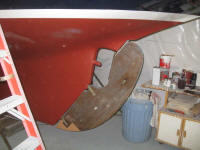 |
|
With the rudder back in place, I could press on with the design and fabrication of the tiller. The rudderpost's new exit location and the requisite angle made for awkward positioning of the original tiller strap, as there was a small flange on the tiller head that had been designed to prevent the tiller (when mounted on the cockpit sole) from flopping down too low. Now, that small flange was unnecessary, so I ground it away to allow the tiller strap to pivot lower, making for a better angle for the new tiller. |
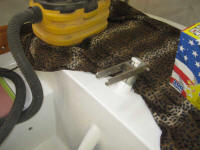 |
|
For the new tiller, I cut two pieces of 5/4 Honduras mahogany of larger dimensions than I needed, since I was as yet unsure of the tiller's new shape; it'd have some curvature, but not too much, and there was still a need for a little dogleg to best accommodate the tiller strap, so I needed the blank to be oversized. Late in the day, I laminated the two boards together to create a blank about 2" thick, 6" wide, and 36" long, from which the tiller would later be milled. Photos of the lamination can be found a bit further down the page. While I was working with the mahogany, I cut an additional strip of the 5/4 material to serve as the basis for a new anchor roller platform to accommodate the ship's Danforth anchor. I left the blank overlong for now while I mocked up the roller and anchor first on the bench, and then up on the foredeck. |
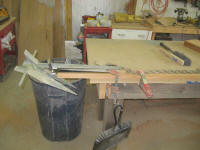
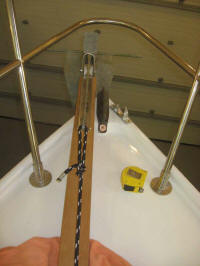 |
|
Up on deck, I determined the overall length of the platform once I'd positioned it and the anchor and roller where I thought they needed to be: far enough forward to avoid hull contact, but not so far forward as to leave the anchor hanging out in unsupported nothingness. I kept the anchor flukes close to, but not touching, the stem. The platform would require a thicker portion at the after end to make up for the height of the toerail upon which the forward section rested, and I measured this at just under 1-1/2". Later, down on the bench, I laminated two sections of 3/4" mahogany to the underside of the main platform for this purpose. |
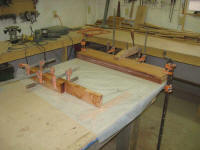 |
|
There were a couple hardware loose ends on deck. The anchor roller and platform would preclude the installation of a port-side bow chock, but I reinstalled one of the original chocks on the starboard side of the stem. |
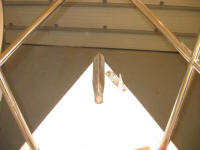 |
|
During the genoa track installation, I'd left off the forward track end stop, pending installation of the genoa cars. Since the ones that came with the boat were in fine shape, I reused them, and with these cars now in place on the track, I wrapped up the track installation by installing the forward track ends. Sorry about the washed-out photo. |
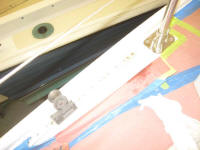 |
|
I expected the new propeller shaft soon, and with the stuffing box back from the machine shop, where I'd had a 3/4" stuffing box bored out for the 7/8" shaft so that I could continue to use the correctly-sized 1-1/2" hose to connect to the existing stern tube, I installed new graphite packing and then clamped the stuffing box in place with its hose. |
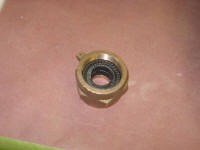
 |
|
One of the reasons (now so seemingly long ago) that we'd contemplated making sweeping changes to the cockpit layout--including wider fiberglass coamings--was to allow possible seating atop the comings for better sailing view. Although we obviously chose a different route forward for a variety of reasons, the desire for at least marginally comfortable seating on the coaming remained. To that end, the owner had located an unrelated advertisement some time ago, which showed a boat under sail with similar wooden coamings, which featured a narrow overhang at the top edge. We planned to replicate that, and since I was milling mahogany, and happened to have appropriate offcuts, it seemed the perfect time to begin this project. I cut two strips of 5/4 mahogany about 2" wide and 36" long; later, up on the boat, I determined a need to trim the length a bit, so that the overhang would run roughly between the forward leg of the stern pulpit and the aft end of the winch platform. The inner edge of the raw platforms would require shaping to match the coamings' curvature, so I set them aside for the moment while I continued on some of the day's other chores. |
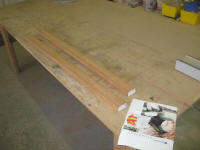 |
|
As usual, I wrapped up the work day with more paint on the head areas--this time with some flattening agent mixed in to hopefully tone down the high gloss to more appropriate levels--and sanded and varnished the cabin sole and other ongoing trim pieces, this time switching to satin rubbed-effect varnish. |

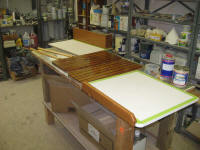 |
|